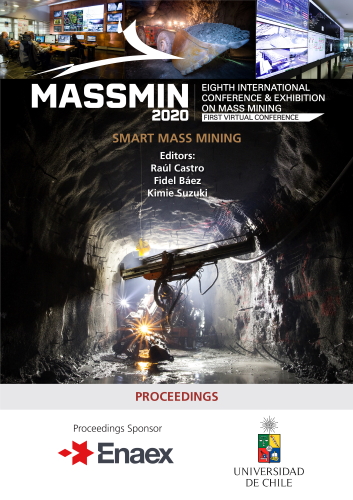Field test and numerical simulation of preconditioning by hydraulic fracturing in hard rock iron mine

|
Authors: Li, W; YuMing, L; Chen, XW; Changming, X; Yao, X; Chu, JW |
This paper is hosted with the kind permission of Lulea University of Technology, International Conference & Exhibition on Mass Mining, 2024.
DOI https://doi.org/10.36487/ACG_repo/2063_14
Cite As:
Li, W, YuMing, L, Chen, XW, Changming, X, Yao, X & Chu, JW 2020, 'Field test and numerical simulation of preconditioning by hydraulic fracturing in hard rock iron mine', in R Castro, F Báez & K Suzuki (eds), MassMin 2020: Proceedings of the Eighth International Conference & Exhibition on Mass Mining, University of Chile, Santiago, pp. 264-274, https://doi.org/10.36487/ACG_repo/2063_14
Abstract:
Preconditioning by hydraulic fracturing (HF) is a vital technique for assisted caving in block caving mines with poor caveability. Selection of suitable powerful fracturing equipment and the layout of fracturing boreholes need to be fully considered before industry application. For this study, simulation of the HF process was first conducted to determine rock breakdown pressure. The simulation was based on field tests of HF preconditioning in an iron mine, and included: rock breakdown pressure, fracture orientation and extending range. The results show that the data for rock breakdown pressure obtained during this HF simulation could be a guideline for allowable water pressure when selecting water injection pumps for real field applications. Additionally, rock breakdown pressure increased linearly with fracturing depth and had a maximum value of 31.64 Mpa in these tests. Based on microseism positioning analysis of hydraulic fractures, the maximum extending distance was measured at about 34 m when the pumping flow rate was 150 L/min. The extension face of the hydraulic fractures was determined to be horizontal, and this was indirectly verified by the increasing water pressure of a nearby monitoring borehole. The results obtained in this study could be a support for the successful application of preconditioning by hydraulic fracturing in hard rock metal mines.
References:
Cao H, Yu SB, Wang H, Qin XS & Yuan Y 2016, ‘Research on comprehensive evaluation of caveability of block caving based on MRMR’, Chinese Journal of Rock Mechanics and Engineering, vol. 35, no. s2, pp. 4148-4153.
Chitombo GP 2010, ‘Cave mining: 16 years after Laubscher’s 1994 paper ‘Cave mining-state of the art’’, Mining Technology, vol. 119, no. 3, pp. 132-141.
He Q, Suorineni FT & Oh J 2016, ‘Review of Hydraulic Fracturing for Preconditioning in Cave Mining’, Rock Mechanics & Rock Engineering, vol. 49, no. 12, pp. 4893-4910.
Joubert PJ 2010, ‘Microseismic monitoring of hydraulic fractures in block cave mines’, Mining Technology, vol. 119, no. 3, pp. 193-197.
Liu HW, Feng XL, Wu M & Li XH 2016, ‘Simulation research on stress change of bottom structure in Pulang copper mine’, Ming Research and Development, vol. 36, no. 5, pp. 28-31.
Liu YM, Li W, Chen XW, Xia CN, Fan WL & Gu XH 2018, ‘Research on pre-conditioning technique in hard rock block caving metal mines’, China Mine Engineering, vol. 47, no. 3, pp. 59-63.
Liu YM 2012, ‘Development trend of block caving method and technical innovation in the second phase of Tongkuangyu copper mine’,·Mining Technology, vol. 12, no. 3, pp. 1-4.
Lowther RJ, Olivier L, Lett JL & Brunton I 2016, ‘Implementation of a surface-based hydraulic fracturing program to successfully propagate a large cave through hard, competent near-surface rock masses to achieve breakthrough’, in C Carr & G Chitombo (eds), Proceedings of MassMin 2016, Sydney, NSW, pp. 83-95.
© Copyright 2025, Australian Centre for Geomechanics (ACG), The University of Western Australia. All rights reserved.
View copyright/legal information
Please direct any queries or error reports to repository-acg@uwa.edu.au
View copyright/legal information
Please direct any queries or error reports to repository-acg@uwa.edu.au
